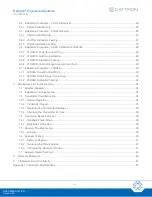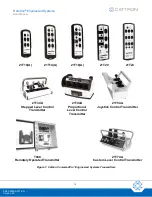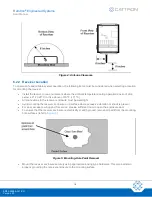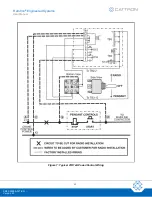
Remtron
®
Engineered Systems
User Manual
13
9M02-9028-A021-EN
Version 4.0
5.1.4 Command Format
This device uses packet-mode, Frequency Modulation (FM) to carry commands in packet form from our
transmitter to our receiver.
To reduce battery drain, our transmitter transmits for a hundredth of a second, which is long enough to send one
packet to our receiver at a repetition rate of either 16 times per second or four times per second.
The rate varies: 16 times per second for three times when sending a command and four times per second when
there is no change in commands and the transmitter is still on. Any time a lever or switch activates, we send all
control settings three times at the 16-per-second rate and then return to the slower rate of four times per second.
Our receiver uses the slower rate for maintaining transmitter timing and provides for a maintained link where one
is used. The only exception to this is the ‘STOP’ switch, which transmits at 16 times per second as long as it is
depressed. In addition to lever and switch positions, each packet contains a unique address and CRC check sum
(described in the next section).
5.1.5 Safety
Safety and loss of control prevention are very important issues at Cattron. We use a unique identification (ID)
code for each user. There are provisions in our system for 65,535 individual codes.
Each transmission includes a CRC check sum, which is a polynomial created by factoring all of the previous bits
transmitted. Once the receiver receives a valid start command from the transmitter, the receiver tracks the time of
the transmitter and ignores all other transmissions that do not fall within the expected time frame of the
transmitter.
Maintained link systems must receive at least one valid transmission each second in order to allow the remote
controlled equipment to function. The receiver provides a loss-of-signal control output that safely shuts down the
equipment if a loss of signal occurs.
The receiver will not allow equipment restart under its control after a loss of signal until a valid system start
command is received from the transmitter. This prevents an unintended start-up from occurring if the transmitter
returns within range of the receiver and is still operating.
The transmitters also check the position of all controls upon start-up. The transmitter does not issue a start
command if any of the controls are pressed at the time the start command begins. Exceptions for lights, horn, bell
or other user functions that do not place machinery in motion can be mapped into our control logic upon request.
FM systems also have a capture effect, where the strongest signal captures the receiver, which rejects the
weaker signal. The operator is seldom more than 300 feet from the controlled machine. Therefore, the transmitter
is the strongest signal present unless other equipment on this band is allowed to operate within 1000 feet of the
location of the receiver.
5.1.6
Carrying Strap for ‘Belly Box’ Controllers
A Shoulder Carrying Strap (Part Number 600057) is supplied with the 21T34A, 21T44A, 21T54A and 21T74A
‘Belly Box’-style controllers which greatly enhances operator comfort. Operators of these ‘Belly Box’-style
controllers are required to use this approved carrying strap with the controller attached at all times.














































